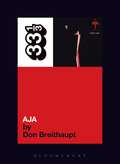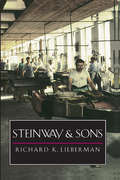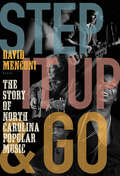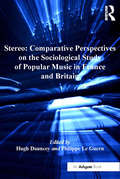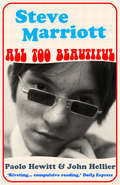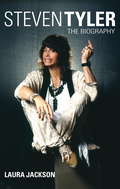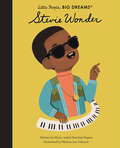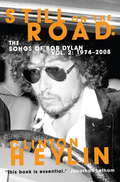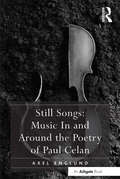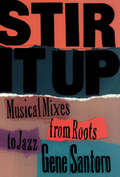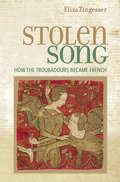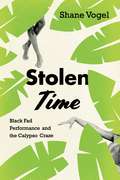- Table View
- List View
Steely Dan's Aja (33 1/3)
by Don BreithauptAja was the album that made Steely Dan a commercial force on the order of contemporaries like Fleetwood Mac, the Eagles and Chicago. A double-platinum, Grammy-winning bestseller, it lingered on the Billboard charts for more than a year and spawned three hit singles. Odd, then, that its creators saw it as an "ambitious, extended" work, the apotheosis of their anti-rock, anti-band, anti-glamour aesthetic. Populated by thirty-fi ve mostly jazz session players, Aja served up prewar song forms, mixed meters and extended solos to a generation whose idea of pop daring was Paul letting Linda sing lead once in a while. And, impossibly, it sold. Including an in-depth interview with Donald Fagen, this book paints a detailed picture of the making of a masterpiece.
Steely Dan's Aja (33 1/3)
by Don BreithauptAja was the album that made Steely Dan a commercial force on the order of contemporaries like Fleetwood Mac, the Eagles and Chicago. A double-platinum, Grammy-winning bestseller, it lingered on the Billboard charts for more than a year and spawned three hit singles. Odd, then, that its creators saw it as an "ambitious, extended" work, the apotheosis of their anti-rock, anti-band, anti-glamour aesthetic. Populated by thirty-fi ve mostly jazz session players, Aja served up prewar song forms, mixed meters and extended solos to a generation whose idea of pop daring was Paul letting Linda sing lead once in a while. And, impossibly, it sold. Including an in-depth interview with Donald Fagen, this book paints a detailed picture of the making of a masterpiece.
Steinway and Sons
by Dr. Richard K. LiebermanThe Steinway—once called the "instrument of the immortals"—is more than the preeminent American piano. It is also a symbol of Old World craftsmanship combined with American capitalism, of technological innovation, and of remarkable family management. This authoritative and entertaining book tells the story of the Steinway piano company and the people behind it.The first book based on the rich archive of Steinway business and family papers at LaGuardia Community College in New York, as well as on interviews with family members and company employees in the United States, Germany, and England, Steinway & Sons describes the making and marketing of an American cultural icon. Founded in New York in 1853 by a German immigrant, the Steinway company quickly rose to prominence on the strength of the distinctive "Steinway sound." For five generations Steinways steered their company in the face of vigorous domestic and foreign competition, bitter labor disputes, temperamental musicians, a fluctuating economy, and wars. Members of the Gilded Age elite, the family also contended with adultery, alcoholism, emotional depression, and long court battles over money. Lieberman discusses the company town the Steinways built in Queens in the 1870s to "escape the machinations of the anarchists and socialists" in the city; the decision to manufacture in both New York and Hamburg, which led to Steinway factories supplying both sides in World War II; the improvements in piano technology that made the Steinway the envy of other piano makers; the company's creative marketing techniques, such as booking celebrated European pianists into American concert halls; the competition from the Japanese-owned Yamaha company; and the sale of the financially troubled company to CBS in 1972. Weaving together themes from social, music, business, labor, and immigrant history, and lavishly illustrated with pictures from the Steinway archive, Steinway & Sons is a rich narrative that casts new light on American cultural history and on a unique family enterprise.
Step It Up and Go: The Story of North Carolina Popular Music, from Blind Boy Fuller and Doc Watson to Nina Simone and Superchunk
by David MenconiThis book is a love letter to the artists, scenes, and sounds defining North Carolina's extraordinary contributions to American popular music. David Menconi spent three decades immersed in the state's music, where traditions run deep but the energy expands in countless directions. Menconi shows how working-class roots and rebellion tie North Carolina's Piedmont blues, jazz, and bluegrass to beach music, rock, hip-hop, and more. From mill towns and mountain coves to college-town clubs and the stage of American Idol, Blind Boy Fuller and Doc Watson to Nina Simone and Superchunk, Step It Up and Go celebrates homegrown music just as essential to the state as barbecue and basketball.Spanning a century of history from the dawn of recorded music to the present, and with sidebars and photos that help reveal the many-splendored glory of North Carolina's sonic landscape, this is a must-read for every music lover.
Step Up To GCSE Music (PDF): Get Up To Speed With Stave Notation And The Other Core Requirements In Just Two Weeks
by Paul TerryWhatever instrument you play, whatever your background, this clear, accessible guide: * provides 14 sessions that can be tackled one-per-day for a fortnight's 'crash course' in the holidays or spaced out over a school term * gets you up to speed with stave notation and the musical language requirements for all GCSE boards * contains regular tests to make sure that you fully understand each topic * helps you to achieve the highest grades.
Stereo: Comparative Perspectives on the Sociological Study of Popular Music in France and Britain
by Philippe Le GuernThe term 'Popular Music' has traditionally denoted different things in France and Britain. In France, the very concept of 'popular' music has been fiercely debated and contested, whereas in Britain and more largely throughout what the French describe as the 'Anglo-saxon' world 'popular music' has been more readily accepted as a description of what people do as leisure or consume as part of the music industry, and as something that academics are legitimately entitled to study. French researchers have for some decades been keenly interested in reading British and American studies of popular culture and popular music and have often imported key concepts and methodologies into their own work on French music, but apart from the widespread use of elements of 'French theory' in British and American research, the 'Anglo-saxon' world has remained largely ignorant of particular traditions of the study of popular music in France and specific theoretical debates or organizational principles of the making and consuming of French musics. French, British and American research into popular music has thus coexisted - with considerable cross-fertilization - for many years, but the barriers of language and different academic traditions have made it hard for French and anglophone researchers to fully appreciate the ways in which popular music has developed in their respective countries and the perspectives on its study adopted by their colleagues. This volume provides a comparative and contrastive perspective on popular music and its study in France and the UK.
Stereo: Comparative Perspectives on the Sociological Study of Popular Music in France and Britain
by Philippe Le GuernThe term 'Popular Music' has traditionally denoted different things in France and Britain. In France, the very concept of 'popular' music has been fiercely debated and contested, whereas in Britain and more largely throughout what the French describe as the 'Anglo-saxon' world 'popular music' has been more readily accepted as a description of what people do as leisure or consume as part of the music industry, and as something that academics are legitimately entitled to study. French researchers have for some decades been keenly interested in reading British and American studies of popular culture and popular music and have often imported key concepts and methodologies into their own work on French music, but apart from the widespread use of elements of 'French theory' in British and American research, the 'Anglo-saxon' world has remained largely ignorant of particular traditions of the study of popular music in France and specific theoretical debates or organizational principles of the making and consuming of French musics. French, British and American research into popular music has thus coexisted - with considerable cross-fertilization - for many years, but the barriers of language and different academic traditions have made it hard for French and anglophone researchers to fully appreciate the ways in which popular music has developed in their respective countries and the perspectives on its study adopted by their colleagues. This volume provides a comparative and contrastive perspective on popular music and its study in France and the UK.
Steve Marriott: All Too Beautiful
by Paolo HewittSteve Marriott was one of the music world's most extraordinary individuals, A supremely gifted songwriter, singer and … schemer. A vocalist from the same mould as Rod Stewart, Eric Burdon and Steve Winwood … but arguably the greatest white soul singer of them all. Marriott never held back from anything, least of all his music, his vocals always possessed an intensity, clarity and maturity that at the time were unmatched by any other singer.His band The Small Faces were the first to be banned from Top of The Pops and were deported from Australia at gunpoint. Steve's next group Humble Pie ruled the stadiums of America but the money earned was diverted by mafia associates and he returned to the UK broke and on the run from the Taxman. In later life he struggled with schizophrenia but always continued playing - blistering gigs in front of small audiences in the pubs and clubs around London. Recently reunited with his old Humble Pie sparring partner Peter Frampton, he was on the verge of a comeback when he was tragically killed in a housefire, aged 44-years-old. A huge influence on a new generation of musicians from Paul Weller to Noel Gallagher, due to his death, Marriott has perhaps not been granted the status in Rock 'n' Roll's pantheon that he deserved. A major reassessment is long overdue. Marriott was simply one of the greatest rock stars of all time.“An exhaustive account of the East End musical maverick, it spans his beginnings as a child prodigy, his memorable work with arch top Mods the Small Faces, and all the way through to his later work with Humble Pie, his subsequent solo career and untimely death in 1991.” Gary Crowley“A riveting account of the singer’s life, crammed with entertaining stories ofrebellion and debauchery and insightful historical background… Compulsivereading.” The Daily Express“One of the best books I’ve read about the backwaters of rock music.” The Daily Mail“A wonderfully researched, eminently readable appreciation of the creative force behind the Small Faces and Humble Pie, who created some of the finest pop, rock ’n’ boogie music of his generation.” ***** Classic Rock“All Too Beautiful traces Marriott’s mercurial career from his upbringing in postwar, bomb-damaged London to his cocaine-ravaged demise in a fire at his Essex home in 1991, aged 44. Revealing… sympathetic, long overdue.” **** Uncut“Ultimately, this is a complex story of extraordinary talent, missed chances, exotic highs and frightening lows… This comprehensive biography of Steve Marriott is as close as we’re going to get to extracting the truth about Britain’s finest white-soul exponent.” ***** Record Collector“Compelling reading.” **** Mojo
Steven Tyler: The Biography
by Laura JacksonSteven Tyler is one of life's natural born survivors. With an exhaustively vibrant personality, this dynamic lead singer has been one of the most distinctive figures in rock music for more than three decades. Raised in a close, loving family, Tyler survived a tough upbringing in the Bronx. His inherent passion for performing and a talent for playing instruments propelled him into rock music as a teenager. He fronted a succession of local bands before meeting the guys with whom he would form Aerosmith in 1970. Laura Jackson reveals the stories behind Tyler's relationships with band members and the many women in his life, his battle with Hepatitis C, and his drug-fuelled meltdown during the late '70s and early '80s when he was snorting pure heroin. She also explores his visits to rehab in the 1980s which saved his life. Tyler has lived a roller coaster life of excess - spending over a million dollars on drugs - but is miraculously still performing. Steven Tyler: the biography tells his incredible story.
Stevie Wonder (little People, Big Dreams)
by Maria Isabel Sanchez Vegara Melissa Lee JohnsonIn this book from the critically acclaimed, multimillion-copy bestselling Little People, BIG DREAMS series, discover the life of Stevie Wonder, the genius behind some of the world’s best-loved songs. At just 8 years old, it was clear that Steveland Judkins was going to be a star. Renamed Stevie Wonder for his astonishing talent on the piano and other instruments, he wrote and performed some of the biggest hits of the 1970s. Stevie became known for his inventiveness, his soulful voice and the social commentary in his lyrics. He is a UN Messenger of Peace and remains one of the music world’s most iconic figures. This inspiring book features stylish and quirky illustrations and extra facts at the back, including a biographical timeline with historical photos and a detailed profile of the great musician’s life.
Stevie Wonder (little People, Big Dreams)
by Maria Isabel Sanchez Vegara Melissa Lee JohnsonIn this book from the critically acclaimed, multimillion-copy bestselling Little People, BIG DREAMS series, discover the life of Stevie Wonder, the genius behind some of the world’s best-loved songs. At just 8 years old, it was clear that Steveland Judkins was going to be a star. Renamed Stevie Wonder for his astonishing talent on the piano and other instruments, he wrote and performed some of the biggest hits of the 1970s. Stevie became known for his inventiveness, his soulful voice and the social commentary in his lyrics. He is a UN Messenger of Peace and remains one of the music world’s most iconic figures. This inspiring book features stylish and quirky illustrations and extra facts at the back, including a biographical timeline with historical photos and a detailed profile of the great musician’s life.
Stevie Wonder's Songs in the Key of Life (33 1/3)
by Zeth LundyLike all double albums, Songs in the Key of Life is imperfect but audacious. If its titular concern - life - doesn't exactly allow for rigid focus, it's still a fiercely inspired collection of songs and one of the definitive soul records of the 1970s. Stevie Wonder was unable to control the springs of his creativity during that decade. Upon turning 21 in 1971, he freed himself from the Motown contract he'd been saddled with as a child performer, renegotiated the terms, and unleashed hundreds of songs to tape. Over the next five years, Wonder would amass countless recordings and release his five greatest albums - as prolific a golden period as there has ever been in contemporary music. But Songs in the Key of Life is different from the four albums that preceded it; it's an overstuffed, overjoyed, maddeningly ambitious encapsulation of all the progress Stevie Wonder had made in that short space of time.Zeth Lundy's book, in keeping with the album's themes, is structured as a life cycle. It's divided into the following sections: Birth; Innocence/Adolescence; Experience/Adulthood; Death; Rebirth. Within this framework, Zeth Lundy covers Stevie Wonder's excessive work habits and recording methodology, his reliance on synthesizers, the album's place in the gospel-inspired progression of 1970s R'n'B, and many other subjects.
Still on the Road: The Songs of Bob Dylan Vol. 2 1974-2008
by Clinton HeylinThis is the second volume in Clinton Heylin's magisterial survey of the songs of Bob Dylan. The first volume - Revolution in the Air which is now available in paperback - charted the rise of Bob Dylan from his first jottings to the full expression of genius in songs such as 'Hard Rain Gonna Fall' and 'The Times They Are a Changin''. Still on the Road begins in 1974 with "Blood on the Tracks", the album filled with masterworks such as 'Tangled Up in Blue' and 'Simple Twist of Fate' that heralded a watershed in Dylan's creative journey, and continues to chart his never-ending fascination with music and the art of song up to 2006's "Modern Times". Praise for Revolution in the Air:'Beg, steal, borrow ... a compelling history of Dylan's mercurial song writing.' Mojo, 5-star review'Better than any biography could ever be, and a crucial Dylan book' Jonathan Letham'Valuable resource' Observer'A gripping new book by Dylan scholar Clinton Heylin so is so far in the deep end that its borderline insane . . [yet] has been devoured with a ravenous, insatiable appetite, and I have even made notes in the margin.' Mark Ellen, Word.'Terrifically interesting for Dylan nuts' Sunday Herald'Manna for completists' Metro 'True to form, Heylin digs deep-way deep-into the songs, mixing cold hard facts with illuminating anecdotes.' - Mark Smith, managing editor, Acoustic Guitar
Still Songs: Music In and Around the Poetry of Paul Celan
by Axel EnglundWhat does it mean for poetry and music to turn to each other, in the shadow of the Holocaust, as a means of aesthetic self-reflection? How can their mutual mirroring, of such paramount importance to German Romanticism, be reconfigured to retain its validity after the Second World War? These are the core questions of Axel Englund's book, which is the first to address the topic of Paul Celan and music. Celan, a Jewish Holocaust survivor who has long been recognized as one of the most important poets of the German language, persistently evoked music and song in his oeuvre, from the juvenilia to the posthumous collections. Conversely, few post-war writers have inspired as large a body of contemporary music, including works by Harrison Birtwistle, György Kurtág, Wolfgang Rihm, Peter Ruzicka and many others. Through rich close readings of poems and musical compositions, Englund's book engages the artistic media in a critical dialogue about the conditions of their existence. In so doing, it reveals their intersection as a site of profound conflict, where the very possibility of musical and poetic meaning is at stake, and confrontations of aesthetic transcendentality and historical remembrance are played out in the wake of twentieth-century trauma.
Still Songs: Music In and Around the Poetry of Paul Celan
by Axel EnglundWhat does it mean for poetry and music to turn to each other, in the shadow of the Holocaust, as a means of aesthetic self-reflection? How can their mutual mirroring, of such paramount importance to German Romanticism, be reconfigured to retain its validity after the Second World War? These are the core questions of Axel Englund's book, which is the first to address the topic of Paul Celan and music. Celan, a Jewish Holocaust survivor who has long been recognized as one of the most important poets of the German language, persistently evoked music and song in his oeuvre, from the juvenilia to the posthumous collections. Conversely, few post-war writers have inspired as large a body of contemporary music, including works by Harrison Birtwistle, György Kurtág, Wolfgang Rihm, Peter Ruzicka and many others. Through rich close readings of poems and musical compositions, Englund's book engages the artistic media in a critical dialogue about the conditions of their existence. In so doing, it reveals their intersection as a site of profound conflict, where the very possibility of musical and poetic meaning is at stake, and confrontations of aesthetic transcendentality and historical remembrance are played out in the wake of twentieth-century trauma.
Still Whispering After All These Years: My Autobiography
by Bob HarrisThe gripping autobiography of broadcasting legend 'Whispering' Bob Harris.Radio 2 DJ Bob Harris first became a household name in the 1970s as the face of live music TV show The Old Grey Whistle Test, and his infectious enthusiasm and ability to discover new musicians has seen him become a national treasure. Today his velvety voice can still be heard on Radio 2's Bob Harris Sunday and Bob Harris Country. Bob tells his story of over 40 years of broadcasting, from the young, passionate music fan who moved to London determined to make music his life, to being presented with an OBE for his services to music broadcasting. Much like his musical heroes, Bob's personal life also had a somewhat rock 'n' roll vibe: he has been married three times, gone bankrupt, fought cancer, weathered a very public spat with a fellow DJ and has had to revamp his career four times. Bob also reveals all about working with the big names of rock, including the Rolling Stones, Elton John, Led Zeppelin and David Bowie.Featuring a 16-page full-colour plate section and foreword by Robert Plant, this is a frank, vibrant and inspiring tale of one of the most influential names on the radio and reveals the story of the man behind the voice.
Stimmungen weben: Eine unterrichtswissenschaftliche Studie zur Gestaltung von Atmosphären
by Julia JungErziehung findet nie im luftleeren Raum statt. Basierend auf dem Atmosphärenbegriff von Gernot Böhme untersucht Julia Jung in ihrer Arbeit Atmosphären im Unterrichtskontext und nimmt hierbei eine Ästhetisierung des Lehrberufs vor. Der Fokus der Untersuchung liegt auf dem empirischen Erfassen und der Versprachlichung eines zumeist unsichtbaren Phänomens zur Entwicklung eines bewusstseinsbildenden und handlungsbefähigenden Konzepts für Lehrpersonen. Mit ihrer Darstellung lenkt Julia Jung den Blick auf das, was Lehrende tagtäglich tun: Sie gestalten Atmosphären. Die Studie leistet damit einen grundlegenden Beitrag zur Unterrichtsforschung und stellt ein Beispiel des empirischen Erfassens von Atmosphären dar.
Stir It Up: Musical Mixes from Roots to Jazz
by Gene SantoroIt's a cliché that the world is shrinking. As Gene Santoro sees it in his second collection of essays, music is one arena where that cliché takes on a real, but paradoxical, life: while music crisscrosses the globe with ever greater speed, musicians seize what's useful, and expand their idioms more rapidly. More and more since the 1960s, musicians, both in America and abroad, have shown an uncanny but consistent ability to draw inspiration from quite unexpected sources. We think of Paul Simon in Graceland, blending Afropop rhythms and Everly Brothers harmonies into a remarkable new sound that captured imaginations worldwide. Or Jimi Hendrix, trying to wring from guitar the howling, Doppler-shifting winds he experienced as a paratrooper. Or Thelonius Monk, mingling Harlem stride piano, bebop, the impressionist harmonies of DeBussey, and a delight in "harmonic space" that eerily paralleled modern physics. From the startling experiments of such jazz giants as Charles Mingus, to the political bite of Bob Marley and Bruce Springsteen, we see musicians again and again taking musical tradition and making it new. The result is a profusion of new forms, media that are constantly being reinvented--in short, an art form capable of seemingly endless, and endlessly fascinating, permutations. Gene Santoro's Stir It Up is an ideal guide to this ever changing soundscape. Santoro is the rare music critic equally at home writing about jazz (John Coltrane, Ornette Coleman, Tom Harrell), rock (Sting, Elvis Costello, P.J. Harvey), and the international scene (Jamaican, Brazilian, and African pop music). In Stir It Up, readers will find thoughtful but unpretentious discussions of such different musicians as David Byrne and Aretha Franklin, Gilberto Gil and Manu Dibango, Abbey Lincoln and Joe Lovano. And Santoro shows us not only the distinctive features of the diverse people who create so many dazzling sounds, but also the subtle and often surprising connections between them. With effortless authority and a rich sense of music history, he reveals, for instance, how Ornette Coleman was influenced by a mystical group in Morocco--the Major Musicians of Joujouka--whom he discovered via Rolling Stone Brian Jones; how John Coltrane's unpredictable, extended sax solos influenced The Byrds, The Grateful Dead, and most significantly, Jimi Hendrix; and how Bob Marley's reggae combined Rastafarian chants with American pop, African call-and-response, and Black Nationalist politics into a potent mix that still shapes musicians from America to Africa, Europe to Asia. A former musician himself, Santoro is equally illuminating about both the technical aspects of the music and the personal development of the artists themselves. He offers us telling glimpses into their often turbulent lives: Ornette Coleman being kicked out of his high school band for improvising, Charles Mingus checking himself into Bellevue because he'd heard it was a good place to rest, the teenaged Jimi Hendrix practicing air-guitar with a broom at the foot of his bed, Aretha Franklin's Oedipal struggle with her larger-than-life preacher-father. Throughout the volume, Santoro's love and knowledge shine through, as he maps the rewarding terrain of pop music's varied traditions, its eclectic, cross-cultural borrowings, and its astonishing innovations. What results is a fascinating tour through twentieth-century popular music: lively, thought-provoking, leavened with humor and unexpected twists. Stir It Up is sure to challenge readers even as it entertains them.
Stolen Song: How the Troubadours Became French
by Eliza ZingesserStolen Song documents the act of cultural appropriation that created a founding moment for French literary history: the rescripting and domestication of troubadour song, a prestige corpus in the European sphere, as French. This book also documents the simultaneous creation of an alternative point of origin for French literary history—a body of faux-archaic Occitanizing songs.Most scholars would find the claim that troubadour poetry is the origin of French literature uncomplicated and uncontroversial. However, Stolen Song shows that the "Frenchness" of this tradition was invented, constructed, and confected by francophone medieval poets and compilers keen to devise their own literary history.Stolen Song makes a major contribution to medieval studies both by exposing this act of cultural appropriation as the origin of the French canon and by elaborating a new approach to questions of political and cultural identity. Eliza Zingesser shows that these questions, usually addressed on the level of narrative and theme, can also be fruitfully approached through formal, linguistic, and manuscript-oriented tools.
Stolen Time: Black Fad Performance and the Calypso Craze
by Shane VogelIn 1956 Harry Belafonte’s Calypso became the first LP to sell more than a million copies. For a few fleeting months, calypso music was the top-selling genre in the US—it even threatened to supplant rock and roll. Stolen Time provides a vivid cultural history of this moment and outlines a new framework—black fad performance—for understanding race, performance, and mass culture in the twentieth century United States. Vogel situates the calypso craze within a cycle of cultural appropriation, including the ragtime craze of 1890s and the Negro vogue of the 1920s, that encapsulates the culture of the Jim Crow era. He follows the fad as it moves defiantly away from any attempt at authenticity and shamelessly embraces calypso kitsch. Although white calypso performers were indeed complicit in a kind of imperialist theft of Trinidadian music and dance, Vogel argues, black calypso craze performers enacted a different, and subtly subversive, kind of theft. They appropriated not Caribbean culture itself, but the US version of it—and in so doing, they mocked American notions of racial authenticity. From musical recordings, nightclub acts, and television broadcasts to Broadway musicals, film, and modern dance, he shows how performers seized the ephemeral opportunities of the fad to comment on black cultural history and even question the meaning of race itself.
Stolen Time: Black Fad Performance and the Calypso Craze
by Shane VogelIn 1956 Harry Belafonte’s Calypso became the first LP to sell more than a million copies. For a few fleeting months, calypso music was the top-selling genre in the US—it even threatened to supplant rock and roll. Stolen Time provides a vivid cultural history of this moment and outlines a new framework—black fad performance—for understanding race, performance, and mass culture in the twentieth century United States. Vogel situates the calypso craze within a cycle of cultural appropriation, including the ragtime craze of 1890s and the Negro vogue of the 1920s, that encapsulates the culture of the Jim Crow era. He follows the fad as it moves defiantly away from any attempt at authenticity and shamelessly embraces calypso kitsch. Although white calypso performers were indeed complicit in a kind of imperialist theft of Trinidadian music and dance, Vogel argues, black calypso craze performers enacted a different, and subtly subversive, kind of theft. They appropriated not Caribbean culture itself, but the US version of it—and in so doing, they mocked American notions of racial authenticity. From musical recordings, nightclub acts, and television broadcasts to Broadway musicals, film, and modern dance, he shows how performers seized the ephemeral opportunities of the fad to comment on black cultural history and even question the meaning of race itself.
Stolen Time: Black Fad Performance and the Calypso Craze
by Shane VogelIn 1956 Harry Belafonte’s Calypso became the first LP to sell more than a million copies. For a few fleeting months, calypso music was the top-selling genre in the US—it even threatened to supplant rock and roll. Stolen Time provides a vivid cultural history of this moment and outlines a new framework—black fad performance—for understanding race, performance, and mass culture in the twentieth century United States. Vogel situates the calypso craze within a cycle of cultural appropriation, including the ragtime craze of 1890s and the Negro vogue of the 1920s, that encapsulates the culture of the Jim Crow era. He follows the fad as it moves defiantly away from any attempt at authenticity and shamelessly embraces calypso kitsch. Although white calypso performers were indeed complicit in a kind of imperialist theft of Trinidadian music and dance, Vogel argues, black calypso craze performers enacted a different, and subtly subversive, kind of theft. They appropriated not Caribbean culture itself, but the US version of it—and in so doing, they mocked American notions of racial authenticity. From musical recordings, nightclub acts, and television broadcasts to Broadway musicals, film, and modern dance, he shows how performers seized the ephemeral opportunities of the fad to comment on black cultural history and even question the meaning of race itself.
Stolen Time: Black Fad Performance and the Calypso Craze
by Shane VogelIn 1956 Harry Belafonte’s Calypso became the first LP to sell more than a million copies. For a few fleeting months, calypso music was the top-selling genre in the US—it even threatened to supplant rock and roll. Stolen Time provides a vivid cultural history of this moment and outlines a new framework—black fad performance—for understanding race, performance, and mass culture in the twentieth century United States. Vogel situates the calypso craze within a cycle of cultural appropriation, including the ragtime craze of 1890s and the Negro vogue of the 1920s, that encapsulates the culture of the Jim Crow era. He follows the fad as it moves defiantly away from any attempt at authenticity and shamelessly embraces calypso kitsch. Although white calypso performers were indeed complicit in a kind of imperialist theft of Trinidadian music and dance, Vogel argues, black calypso craze performers enacted a different, and subtly subversive, kind of theft. They appropriated not Caribbean culture itself, but the US version of it—and in so doing, they mocked American notions of racial authenticity. From musical recordings, nightclub acts, and television broadcasts to Broadway musicals, film, and modern dance, he shows how performers seized the ephemeral opportunities of the fad to comment on black cultural history and even question the meaning of race itself.
Stolen Time: Black Fad Performance and the Calypso Craze
by Shane VogelIn 1956 Harry Belafonte’s Calypso became the first LP to sell more than a million copies. For a few fleeting months, calypso music was the top-selling genre in the US—it even threatened to supplant rock and roll. Stolen Time provides a vivid cultural history of this moment and outlines a new framework—black fad performance—for understanding race, performance, and mass culture in the twentieth century United States. Vogel situates the calypso craze within a cycle of cultural appropriation, including the ragtime craze of 1890s and the Negro vogue of the 1920s, that encapsulates the culture of the Jim Crow era. He follows the fad as it moves defiantly away from any attempt at authenticity and shamelessly embraces calypso kitsch. Although white calypso performers were indeed complicit in a kind of imperialist theft of Trinidadian music and dance, Vogel argues, black calypso craze performers enacted a different, and subtly subversive, kind of theft. They appropriated not Caribbean culture itself, but the US version of it—and in so doing, they mocked American notions of racial authenticity. From musical recordings, nightclub acts, and television broadcasts to Broadway musicals, film, and modern dance, he shows how performers seized the ephemeral opportunities of the fad to comment on black cultural history and even question the meaning of race itself.
Stolen Time: Black Fad Performance and the Calypso Craze
by Shane VogelIn 1956 Harry Belafonte’s Calypso became the first LP to sell more than a million copies. For a few fleeting months, calypso music was the top-selling genre in the US—it even threatened to supplant rock and roll. Stolen Time provides a vivid cultural history of this moment and outlines a new framework—black fad performance—for understanding race, performance, and mass culture in the twentieth century United States. Vogel situates the calypso craze within a cycle of cultural appropriation, including the ragtime craze of 1890s and the Negro vogue of the 1920s, that encapsulates the culture of the Jim Crow era. He follows the fad as it moves defiantly away from any attempt at authenticity and shamelessly embraces calypso kitsch. Although white calypso performers were indeed complicit in a kind of imperialist theft of Trinidadian music and dance, Vogel argues, black calypso craze performers enacted a different, and subtly subversive, kind of theft. They appropriated not Caribbean culture itself, but the US version of it—and in so doing, they mocked American notions of racial authenticity. From musical recordings, nightclub acts, and television broadcasts to Broadway musicals, film, and modern dance, he shows how performers seized the ephemeral opportunities of the fad to comment on black cultural history and even question the meaning of race itself.
